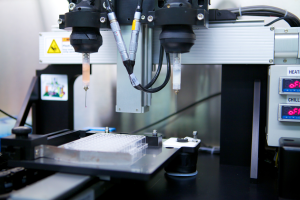San Diego-based 3D bioprinting company Organovo made a breakthrough in Novemeber of last year when their researchers successfully tested the effects of a toxic drug (good ol’ toxic Tylenol) on an array of 3D printed liver cells. Though their internal studies revealed that 3D printed liver cells react similarly to Acetaminophen the way that they would in the natural environment of the human body, these results had yet to be verified by outside researchers. In January, the company first sent its 3D printed liver assays to an outside lab, that of biotech giant Roche Pharmaceutical, for study. Organovo has finally heard back from their research partner and the results are quite positive.

At the 3D Cell Culture 2014 conference in Germany, yesterday, Dr. Adrian Roth, head of mechanistic safety for Roche, publicized his results from a study of Organovo’s 3D printed liver cells. Dr. Roth explained that the liver assay reacted to toxins in the appropriate manner, listing two critical findings:
- “Organovo’s 3D Liver system was able to distinguish a toxic drug known to cause drug induced liver injury (DILI) from a close chemical analogue that is known to be non-toxic.
- The toxicity of the toxic compound was detected at physiologically relevant doses, an important observation not previously reported with the same compounds in other model liver systems.”
In other words, the 3D printing liver cells could be used to distinguish between two similar chemicals with completely different effects on the liver, one toxic and one non-toxic. Additionally, the 3D printed liver cells were used to detect the level of toxicity caused by the toxic chemical, which hasn’t been reported with other (i.e., two-dimensional) liver cell tests. If further research echos Roche’s findings, this could be a big deal for the bioprinting firm.
The company insists that 3D cellular arrays will prove to be much more effective for drug testing than their traditional, 2D counterparts. By mimicking the 3D environment of the human body with similar architectures, cellular densities, and multiple cell types, 3D printed cells will react like actual organs when it comes to pharmaceutical research. Positive feedback from researchers could push Organovo to the forefront of drug testing, supplanting current 2D cell suppliers. The company’s CEO, Keith Murphy, tells Life Science Leader that the cost of failed drugs account for 40% of pharmaceutical spending, saying, “So if the drug spending is more than $50 billion per year, there is an opportunity to save more than $20 billion. Even if using 3D bioprinting testing only causes modest improvement, there is significant potential benefit.” More importantly, their bioprinting process could bring drugs to market more quickly, while bypassing the need for animal testing and increasing the efficacy of cellular testing.
Once the company obtains FDA approval for its 3D printed liver testing systems, Organovo will be able to conduct tests for drug manufacturers and even lease or sell their NovoGen MMX Bioprinters to companies to perform their own research. In the mean time, the firm is in the process of preparing more cell types for the bioprinting process, including kidney and breast cancer tissues. Bioprinting organs is still about six years down the line, with Murphy saying, “Everyone quickly thinks about large organs; bioprint an organ and implant it into the body. But, instead, we are focused a little smaller. Think of a 3D bioprinted liver patch to help repair a damaged liver. We could take cells from the patient to create the patch, which would almost assure no immune response.”
Bioprinting a complete organ would certainly satiate our sci-fi dreams, but the technology as a whole is exciting enough that I’ll take what I can get.
Source: Motley Fool


